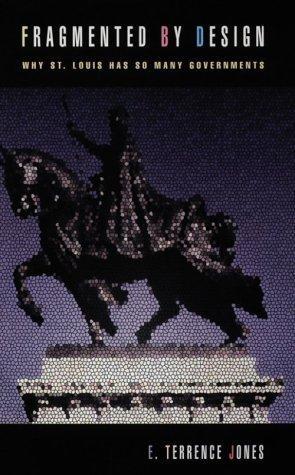Book: Fragmented by Design: Why St. Louis Has So Many Governments by E. Terrence Jones
Genre: Nonfiction
Publisher: Palmerston & Reed
Publication date: 2000
Pages: 168
Source: St. Charles City-County Library. I had to make use of reciprocal borrowing privileges to get hold of this title. It’s out of print and everyone in our book club was competing for the limited number of copies in the nearby libraries.
 A book about how St. Louis came to have 91 municipalities
A book about how St. Louis came to have 91 municipalitiesSummary: St. Louis City is not part of St. Louis County. St. Louis County has 90 municipalities plus a number of unincorporated areas. The City separated from the County in 1876 at a time when the City had 80% of the population and more educated and sophisticated residents. St. Louis City didn’t want to be saddled with the expense of infrastructure developments in the County at a time when it was mostly rural and filled with country bumpkins.
What happened more than one hundred years ago furnishes hints about the way St. Louisans are. If the problem is accommodating diverse interests, in this case urban in the City versus rural in the County, the answer is to separate governments. The predisposition is not to seek win-win solutions within a larger framework but instead for each set of interests to go its own governmental way. The fear of loss outweighs the potential for gain. Homogeneity trumps heterogeneity. (pp. 23, 24)
This instinct to create more governments played out in the suburbs that developed over the next century in St. Louis County, when the population exploded. Rather than allow themselves to be annexed into existing County towns, new neighborhoods joined together to form their own new municipalities.
Over the years, a variety of attempts have been made to restructure things. The business community finds the plethora of governments onerous to deal with and would love to see a streamlined system. In our fragmented system, governments compete with each other when, from a more regional viewpoint, it’s obvious that cooperation would work better for all involved. The efforts to reunite the City and County had two things in common — they failed and they didn’t even attempt to touch school districts, “the third rail of metropolitan reform.” (p. 81)
Thoughts: When I reviewed the government document, For Each and Every Child on Monday, it was probably clear that I think improved education is a fundamental solution to the problems we have in St. Louis. Since I facilitated our book club’s conversation on this book, I was careful to try to steer us away from education so that it didn’t become all about my issue. But it went there anyway. That’s something that readers have in common — putting a high value on education and the love of learning.
Our school districts aren’t quite as fragmented as our municipalities — there are 24 of them, including the Special School District that serves special needs students throughout the County. Still, among these, there are huge disparities between the “haves” and the “have-nots.” Kirkwood, where our book club meets, is a “have.” Normandy, where Michael Brown was educated, is a “have-not.”
Our book club discussion gravitated toward changes that would promote equity in education, in particular the dramatic solutions that I mentioned on Monday:
- move away from property tax as a funding mechanism for schools
- make a giant unified school district of all 24 of the districts in the City and County
Fortunately, the author of the book, Terry Jones, joined us that night. He reined us in. We had a huge turn-out for our book club, but 15 passionate people and our allies can’t make these dramatic changes happen. We are never going to get our friends and neighbors to vote for something they would fear might result in the loss of our good schools — no matter the potential gain in fairness or the economic advantages to the country as a whole described in For Each and Every Child.
In frustration, someone asked Terry what he thought might work. His suggestion was one that showed up in the Ferguson Commission’s Calls to Action from the Working Group on Child Well Being and Education Equity, part of number 23: Create universal, Pre-K for children ages 3-4.
For Each and Every Child devotes a section to Early Childhood Education, citing research that shows improved results in:
- student achievement
- reduced special education needs
- healthier lifestyles
- lower social costs
- decreased crime rate
- increased high school graduation
- increased college attendance and completion
- higher reading and math skills
All of this is achieved at a much lower cost in pre-school than any attempts to remedy them later in life.
Our book group was not entirely satisfied with Pre-K as the major response to the problem of education inequity in St. Louis.
If the Pre-K is implemented by the current school districts, there will still be disparities in the quality of the education between Normandy and Kirkwood. Terry proposed that an Early Childhood Education program could be structured like the Special School District to encourage high-quality throughout the system.
In fact, Fragmented by Design makes it clear that St. Louis can succeed in some regional efforts. We do it by making nongovernmental and extra-governmental entities that transcend our boundaries. The Special School District is an example of that.
The other downside is that once students graduate from Pre-K, they will be sent into unequal K-12 school districts. The Ferguson Commission’s Calls to Action envision regional efforts that reflect the way St. Louis does regional efforts. Instead of a dramatic change to the tax code or the school districts, they recommend a variety of measures labeled Coordination and Innovation. These include:
44. Create a data driven and annual reporting process capable of accounting for how regional services are provided and how dollars are spent to meet the needs of children and youth
46. Create an “innovative education center/hub” capable of building an inclusive, collaborative, and multi-disciplined environment focused on leading our region into the 21st Century from early childhood to post-secondary.
Besides the Ferguson Commission, Terry Jones recommended an organization to align ourselves with if we value a better educational outcome for all students in the St. Louis region: Vision for Children at Risk and its associated Regional Early Childhood Council.
Appeal: Fragmented by Design presents history that all St. Louisans should know. For a preview, check out this video made by students at Harris Stowe State University:
 Challenges: This is my 13th nonfiction book of the year. My goal was 16 books for the 2015 Nonfiction Reading Challenge, so I’m in good shape!
Challenges: This is my 13th nonfiction book of the year. My goal was 16 books for the 2015 Nonfiction Reading Challenge, so I’m in good shape!
Other Reviews: Richard Bose wrote an excellent summary with details about each of the reunification attempts for nextSTL.
How does fragmentation and consolidation work where you live?

